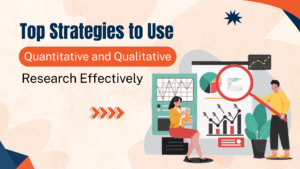In today’s data-driven world, using quantitative and qualitative research together helps researchers get a full picture. While numbers offer measurable insights, stories reveal the reasons behind them; because of that, many learners now focus on quantitative data analysis training to enhance their skills. This combined approach makes research data analysis stronger, especially when developing a research plan and using quantitative statistical analysis to support real-world decisions.
Why Combining Quantitative and Qualitative Research Matters

- Deeper Understanding: Numbers from quantitative and qualitative research tell you what’s happening, while quotes and opinions explain why it’s happening.
- Stronger Decisions: If your decisions rely only on one method, you might miss key points. But if you use both, your actions will be more confident and backed by a full story.
- Clearer Patterns: Sometimes, numbers don’t make sense until you talk to people. Because of that, blending methods gives more context during quantitative data analysis training.
- Trust Building: Stakeholders trust your research data analysis more when it’s based on solid facts and real human voices.
- Helpful in Planning: If you’re developing a research plan, starting with qualitative feedback and testing it with surveys is a strong combo.
- Validation of Ideas: Sometimes, ideas sound good, but the numbers don’t support them. Or the numbers say something, but people feel differently. Using both helps verify what really works.
- Complete Analysis: Without quantitative statistical analysis, you may miss the broader view. Without interviews, you may miss emotions. So, both together bring balance.
Top Strategies to Use Quantitative and Qualitative Research Effectively

- Start with Your Research Goals: If you want numbers, begin with quantitative and qualitative research goals that align with your project. If you’re exploring new ideas, start with qualitative interviews first.
- Use Mixed Method Design: Combine surveys (quantitative) with interviews (qualitative) to cover all angles. This mix is taught in quantitative data analysis training.
- Validate Results: Use one method to check the other. For example, after interviews, run a survey to confirm those patterns. It strengthens your research data analysis.
- Match Tools with Questions: Use statistical software for numeric data and thematic tools for responses. Each method helps in developing a research plan that fits your topic.
- Timely Integration: Don’t wait until the end. Use both methods during planning, execution, and reporting for full value.
- Be Open to Surprises: Sometimes, quantitative statistical analysis gives unexpected results. Use qualitative interviews to dig deeper and understand the cause.
- Segment Your Data: For example, separate age groups in surveys, then ask those groups in focus sessions. This lets your research speak louder.
- Let Both Methods Support Each Other: If numbers confuse you, use words to explain them. If words go too far, use numbers to narrow the focus.
Common Mistakes to Avoid
- Using Only One Method: Relying only on quantitative and qualitative research separately weakens your conclusions.
- Ignoring Training: Skipping quantitative data analysis training can lead to wrong numbers and incorrect charts.
- Mixing Results Too Soon: Wait until you’ve fully explored both sets of data before combining them in your research data analysis.
- Lack of a Clear Plan: Without a strong structure in developing a research plan, your project might go off track.
- Misreading Stats: If you don’t know how to use quantitative statistical analysis, get expert help to avoid wrong insights.
- Forgetting Context: Numbers mean little without knowing the “why.” So always support them with real voices.
- Not Updating Questions: As you move forward, both methods may need changes. Don’t keep old questions that no longer fit.
Two Dos and Don’ts
✅ Do This:
- Plan for Both Methods: While using quantitative and qualitative research, include time and tools for both from the beginning.
- Get Trained Properly: Take help from experts or join quantitative data analysis training to understand data better.
❌ Don’t Do This:
- Don’t Overcomplicate: Keep your research data analysis simple. Too many charts or themes may confuse your audience.
- Don’t Skip Reviews: When developing a research plan, review it midway to check what’s working and what’s not.
Benefits of Using Both Research Methods Together
Using both techniques opens many doors. Here’s how it helps – and how Resilient Foundation supports you.
- Balanced Understanding: Combining quantitative and qualitative research gives you the full story – facts plus feelings.
- Improves Accuracy: With better numbers and deeper stories, your research becomes more accurate. That’s why we include both in our Resilient Foundation projects.
- Faster Decisions: Because of clear quantitative data analysis training, your team will be ready to take quick actions based on what’s real.
- Inspires Innovation: When data talks and people’s voices back it up, creative ideas flow faster. We’ve seen this at the Resilient Foundation in every step of our growth.
- Effective Planning: Whether you’re starting a new study or improving a service, strong research data analysis brings the clarity you need.
- Helps in Community Impact: Properly developing a research plan at Resilient Foundation creates more powerful outcomes.
- Strong Reporting: Your reports carry more value when both methods are used. Decision-makers understand things better.
- Clarity in Stats: By using quantitative statistical analysis, our team supports social impact with data that’s easy to trust.

